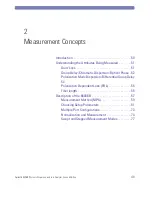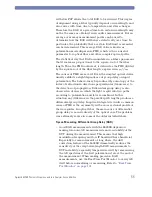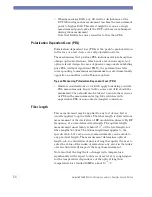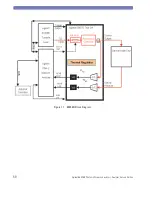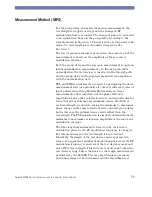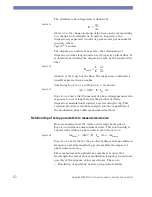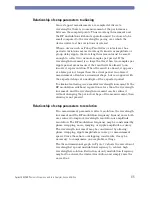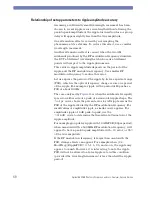
Agilent 86038B Photonic Dispersion and Loss Analyzer, Second Edition
59
Measurement Method (MPS)
For the group delay/chromatic dispersion measurement, the
wavelength is stepped or swept and the change in RF
modulation phase is recorded. The change of phase is converted
to an equivalent change in the group delay according to the
formula shown in
. The derivative of group delay with
respect to wavelength gives chromatic dispersion. See
.
The loss or gain measurement proceeds in the same way, but the
measurement is based on the amplitude of the recovered
modulation envelope.
Both the group delay and the loss/gain measurement require an
initial normalization measurement of a through path. After
normalization, the test devices is inserted in the through path
and the group delay and loss/gain is measured in comparison
with the normalization data.
PDL and PMD measurements are made by performing the above
measurement four (or optionally six) times at different states of
input polarization. Using Mueller Matrix analysis, these
measurements allow calculation of the phase shift and
amplitude for any other polarization state, and in particular for
those that give maximum and minimum values. The DGD at
each wavelength is calculated using the minimum to maximum
phase change in the same formula used to calculate group delay,
but in this case the polarization is varied rather than the
wavelength. The PDL information is similarly obtained from the
minimum to maximum variation in amplitude of the recovered
modulation envelope.
The fiber length measurement is based on the variation of
modulation phase as the RF modulation frequency is changed.
For this measurement, the wavelength is kept constant.
Intuitively, the length of the test device can be expressed in
terms of an equivalent number of modulation periods. As the RF
modulation frequency is increased, the test device is more and
more RF cycles in length. This increase is more rapid when the
test device is long. This is the basis for the length measurement
performed by the 86038B. The very high frequency accuracy
and tuning range of the instrument and the algorithm used
Summary of Contents for 86038B
Page 1: ...Agilent 86038B Photonic Dispersion and Loss Analyzer User s Guide ...
Page 4: ...4 ...
Page 20: ...20 Agilent 86038B Photonic Dispersion and Loss Analyzer Second Edition ...
Page 34: ...34 Agilent 86038B Photonic Dispersion and Loss Analyzer Second Edition Figure 2 b Rear Panel ...
Page 78: ...78 Agilent 86038B Photonic Dispersion and Loss Analyzer Second Edition ...
Page 92: ...92 Agilent 86038B Photonic Dispersion and Loss Analyzer Second Edition ...
Page 202: ...202 Agilent 86038B Photonic Dispersion and Loss Analyzer Second Edition End Sub ...
Page 348: ...348 Agilent 86038B Photonic Dispersion and Loss Analyzer Second Edition ...
Page 349: ......





